Disinfection Misting Treatments:
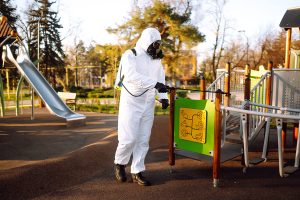
Disinfectant solution is an all-natural, organic, non-toxic, non-irritant, environmentally and ecologically safe, sanitizing and disinfecting solution. It is produced from Neutral Electrolyzed Watertechnology and the applications are infinite. It’s used for processes that require a sterilizing, disinfecting, cleaning or water purification facility. It’s a powerful solution that fully sterilizes bacteria rapidly at a lower concentration than chemical disinfectants. It can be used on a wide range of applications, as it’s a water based solution that’s non-toxic, non-hazardous, non-flammable, alcohol and chemical free.
Where to Apply:
It can be applied to high risk infection areas including: Clinics, Hospitals, Ambulances, Slaughterhouses, F & B Production, Catering, Education, Sports, Salons, Cinemas, Hotels and Food Products.

What Should I Expect During the Disinfecting Misting Treatment?
The treatment involves the use of an Electric Ultra Low Volume Sprayer designed to disperse the solution to fine micron particles that will appear to float in the air as they slowly settle onto the surfaces. This will result in the surfaces becoming moist for a short period after Disinfecting Misting Treatment. Areas should not be wiped clean because this is when the disinfectant acts. After the Disinfecting Misting Treatment, you must allow 1 hour post completion depending on the ventilation of the premise.
Preparation of Site Before the Disinfecting Misting Treatment:
It is important to follow the below steps before treatment commences. This is to ensure the Disinfecting Misting Treatment can be safely conducted and that maximum effectiveness is achieved.
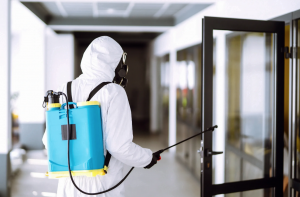
- Because the Misting Unit disperses fine micron particles into the air, any materials that could be damaged by moisture will need to be removed from the treated area(s), such as artwork/ documents.
- Because the Misting Unit disperses fine micron particles into the air, all food items MUST be removed from the treated area(s). Food containers and utensils should be placed away in cupboards.
- Before commencing the Disinfecting Misting Treatment all ELECTRICAL EQUIPMENT should be covered with a piece of plastic. Such as: Computer Monitors/Keyboards/Televisions/Stereos.
- Any items being covered or removed from the treated area prior to commencing the Disinfecting Misting Treatment should be sanitised with a safe product such as an Alcohol-Based Wipe or Aerosol Spray.
- Before the Disinfecting Misting Treatment, you need to allow clear access for the technician and remove any trip hazards that might be in the way when treatment commences.
- If your home/office has fish tanks/aquariums/ponds, they need to be covered with plastic and secured.
Preparation of the Site After the Disinfecting Misting Treatment:
After the Disinfecting Misting Treatment, there are few tips to follow that should be noted for continued success between disinfecting treatments:
- After Disinfecting Misting Treatment, you need to allow 2 to 4 hours before re-entry into treated areas. Depending on the area treated it might take longer to dry and ventilate.
- Wash any food/drinking containers before use if they were left in an exposed location.
Ensure any new materials brought back into the treated area(s) are sanitised appropriately.
Fogging Application/Treatments:
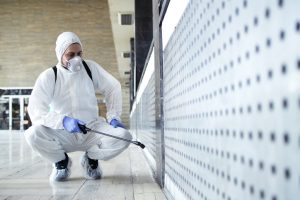
What Is Fogging?
Fogging is a means of disinfecting larger areas with a fogging machine that sprays the disinfectant into a very fine mist. There are two main types of foggers, Thermal (Steam) Fogger or a Cold/Ultra-Low Volume (ULV) Fogger. To spray antimicrobial treatments cold fogging is recommended.
What Are Cold Foggers?
Cold Foggers are a device you can use to fight pest problems both indoors and outdoors. You can use them to get rid of mould, unpleasant odours and for sanitising purposes. A cold fogger is “cold” because it’s the opposite of a thermal fogger. Cold foggers don’t use heat to vaporize the fogging liquid and turn it into a fog. Instead, they use cold spraying methods, which, in most cases use high amounts of air pressure to spray the fogging liquid out into tiny particles. The most popular type of cold fogger is the Ultra-Low Volume (ULV) Fogger. Most of the time ULV foggers are considered the same as cold foggers.
How Do They Work?
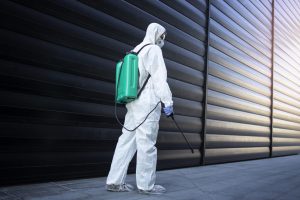
Inside the casing of a cold fogger is an electric motor. This is the main part of the ULV fogger, since it sprays the liquid out as small particles. The power of the airflow will depend on the power of the motor.
Particle Size
The advantage that ULV foggers have over thermal foggers is that they allow you to control the particle size. On standard ULV foggers, you’ll have the option of setting the particle size from 10-50 microns. You can adjust the droplet size by either turning the flow valve or pushing a button on the fogger. Higher airflow will produce larger particles, while lower airflow will produce smaller particles. This is definitely useful if you need to fog in different areas. You might use smaller particles indoors since they stay in the air longer and can reach smaller gaps and holes in the walls and floor, as well as, the spaces behind furniture and other tight areas.
Benefits of Fogging Over Normal Spraying

Fogging penetrates normally inaccessible areas resulting in a more thorough stericide decontamination, producing droplets as small as microns which reduce condensation, surface wetting and possible corrosion. Area coverage is more uniform and the fog penetrates cracks, crevices, ventilation systems and other challenging areas like high corners and underneath furniture. Wiping down surfaces can actually spread germs, especially when only a cloth is used to clean all surfaces. On the other hand, fogging kills the germs where they lie and also prevents them being transferred from one place to another (known as cross contamination).
Where is Fogging Used?
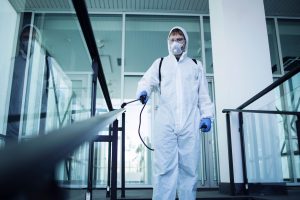
ULV Cold Fogging has been used for a number of years, mainly in food preparation factories to combat pathogens, mould and mildew. Today with so many business premises having been closed because of Covid-19 it’s more important than ever to fog your facility on a regular basis to avert the build-up of these pathogens and fogging; prior to re-opening. This should be an essential part of your strategy to maximise protection for both staff and customers alike.
Fogging is Regularly Used in The Following Applications
Food Processing Plants, Restaurants, Transportation (Cruise Ships, Airplanes, Cargo Containers, Transport Vehicles), Pharmaceutical Packaging, Hospitals, Schools, Day Care Centres, Veterinaries, GP Clinics, Home & Commercial Buildings, Pest Control and Animal Husbandry.
